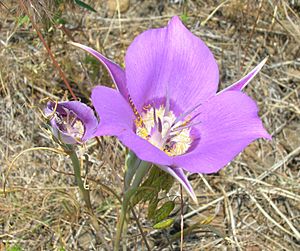Sagebrush mariposa lily facts for kids
Quick facts for kids Sagebrush mariposa lily |
|
|---|---|
 |
|
| Scientific classification | |
| Genus: |
Calochortus
|
| Species: |
macrocarpus
|
| Synonyms | |
|
Mariposa macrocarpa (Douglas) Hoover |
|
The sagebrush mariposa lily (scientific name: Calochortus macrocarpus) is a beautiful flower found in North America. It's a type of plant that grows from a bulb, much like a tulip. This plant belongs to the lily family. It comes back year after year, making it a perennial.
Where Does It Grow?
This special lily grows naturally in parts of North America. You can find it in the Northwestern United States. This includes states like Washington, Oregon, Idaho, and western Montana. It also grows in northern California and northern Nevada. A small part of southern British Columbia in Canada is also home to this plant.
It likes to live in certain places, called habitats. These include the dry lands of the Great Basin. It also thrives in the mountains of the Cascade Range.
What Does It Look Like?
Leaves and Bulbs
The sagebrush mariposa lily has unique leaves. They are a pretty blue-green color. They also look a lot like blades of grass.
The plant grows from a bulb under the ground. These bulbs are shaped like a carrot. They get thinner towards the end.
Flowers
The flowers of this lily are quite large. Each flower has three petals. They are usually a mix of pink and purple colors. These lovely flowers typically bloom in June.
How Was It Used?
Long ago, First peoples in southern British Columbia used this plant. They would gather the bulbs of the sagebrush mariposa lily. This gathering usually happened from April to June.
The bulbs were an important food source. People could eat them raw, just as they were. They also cooked the bulbs before eating them.

